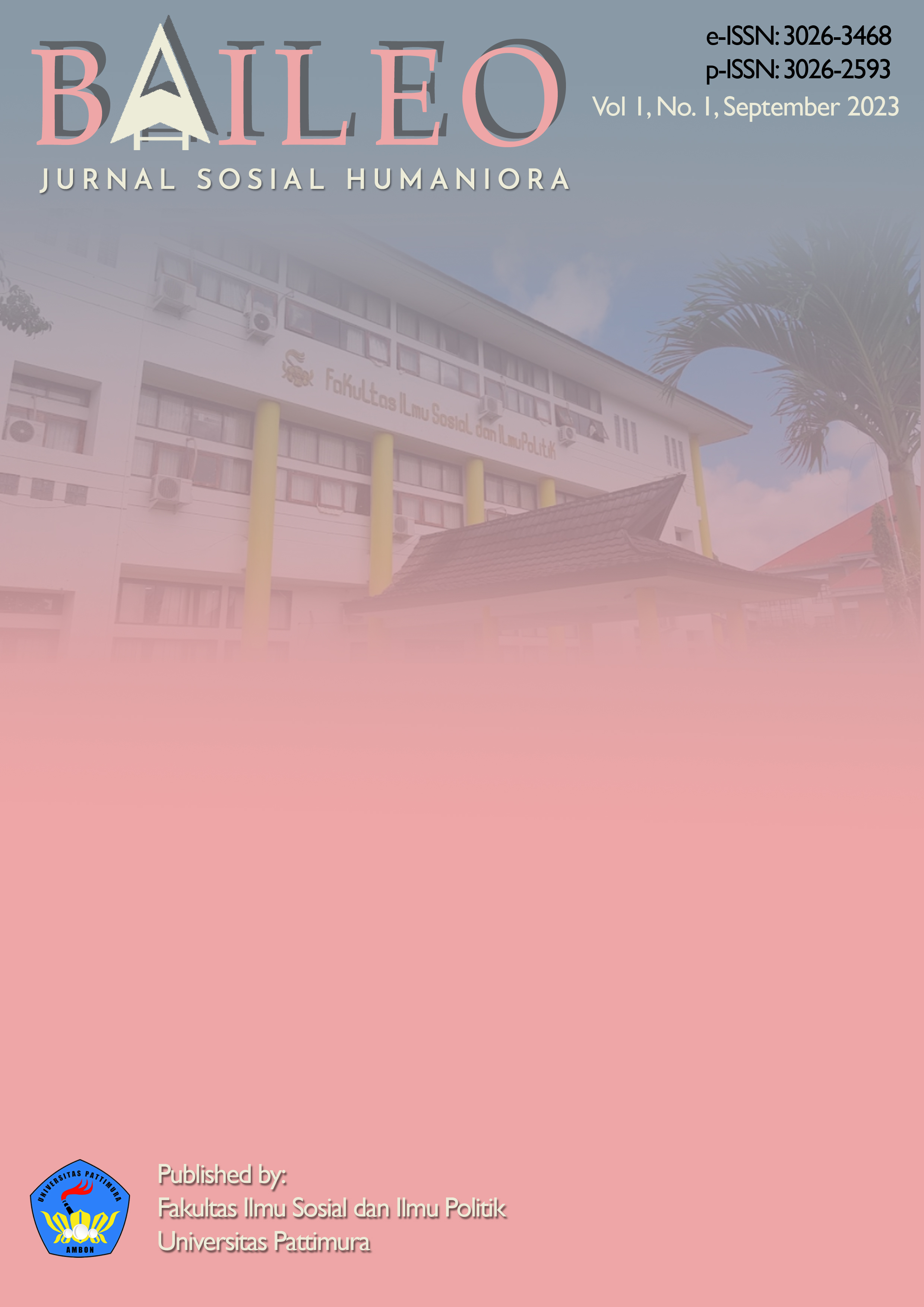Community-Based Health Movement: Social Innovation and Stunting Revolution in Supiori Regency
Abstract
This article investigates the role of community-based health movements as a form of social innovation in addressing stunting in Supiori Regency, Papua. The study aims to explore how integrated strategies combining government initiative and grassroots participation can effectively combat stunting, which is not merely a health issue but also deeply rooted in the region’s socio-economic and cultural context. Using a structured descriptive qualitative approach, the research involved field observations, interviews with key stakeholders, and policy analysis to understand the dynamics and outcomes of stunting interventions. The findings reveal that Supiori Regency has successfully implemented a hybrid model that combines top-down governmental directives with bottom-up community engagement. This approach, driven by strong leadership—particularly the active role of the Regent—has facilitated cross-sectoral coordination among health, education, and economic departments. It has also promoted community ownership and responsiveness, contributing significantly to stunting reduction. However, the study also uncovers that stunting persists even among families receiving social protection assistance, indicating the limitations of sectoral and welfare-based approaches when applied in isolation. The novelty of this study lies in its emphasis on stunting as a multidimensional challenge requiring systemic and inclusive solutions beyond the health sector. It contributes to the development of social and human sciences by providing a grounded model of collaborative governance, localized innovation, and integrated public health strategy. The study recommends adopting holistic, community-centered frameworks in policymaking, particularly in marginalized regions, to achieve sustainable health outcomes.
Downloads
References
Arsin, A. A., & Syafar, M. (2020). Determinants of stunting in children under five in the Bone regency. Enfermería Clínica, 30, 371–374. https://doi.org/10.1016/j.enfcli.2019.10.103
Asipi, L. S., Rosalina, U., & Nopiyadi, D. (2022). The analysis of reading habits using Miles and Huberman interactive model to empower students’ literacy at IPB Cirebon. International Journal of Education and Humanities, 2(3), 117–125. https://doi.org/10.58557/ijeh.v2i3.98
Azwar, A., Kabullah, M. I., Zamzami, L., & Dermawan, R. (2021). Managing policies for stunting prevention during the COVID-19 disaster: the case of West Sumatra Province. E3S Web of Conferences, 331, 2011. https://doi.org/10.1051/e3sconf/202133102011
Bans-Akutey, A., & Tiimub, B. M. (2021). Triangulation in research. Academia Letters, 2. https://doi.org/10.20935/AL3392
BKPK, H. (2023, January 25). Angka Stunting Tahun 2022 Turun Menjadi 21,6 Persen. Kabar BKPK, 1. https://www.badankebijakan.kemkes.go.id/angka-stunting-tahun-2022-turun-menjadi-216-persen/
Boleu, F. I., Sudrajat, T. A., Keno, A., Samloy, V., & Saketa, J. (2021). Pemanfaatan Kebun Pekarangan untuk Pemenuhan Pangan Keluarga pada Masa Pandemi Covid-19. KAMBOTI: Jurnal Sosial Dan Humaniora, 1(2), 154–165. https://doi.org/10.51135/kambotivol1iss2pp154-165
BPS. (2023). Angka Kemiskinan 2022. https://www.bps.go.id/indicator/28/301/1/angka-partisipasi-sekolah-a-p-s-.html
Clark, T., Foster, L., Bryman, A., & Sloan, L. (2021). Bryman’s social research methods. Oxford university press.
Creswell, J. W. (2017). Research Design: Qualitative, Quantitative, and Mixed Methods Approaches. Sage publications.
Devie, M. P., Mardani, F. A., Damayanti, R. F., Pramana, A. A., Akhyar, R. F., Wahdah, N. A., Tauriestya, F. A., Miratmaka, D. T., Sugesta, M. Y. I., & Noza, D. E. (2023). Penguatan Literasi Gizi untuk Pencegahan Stunting di Desa Jurangsapi. Lumbung Inovasi: Jurnal Pengabdian Kepada Masyarakat, 8(1), 79–92. https://doi.org/10.36312/linov.v8i1.1120
Edwards, B., Gray, M., & Borja, J. B. (2020). The impact of natural disasters on violence, mental health, food insecurity, and stunting in the Philippines: Findings from the Longitudinal Cohort Study on the Filipino Child. Mental Health, Food Insecurity, and Stunting in the Philippines: Findings from the Longitudinal Cohort Study on the Filipino Child (1/12/2020). https://doi.org/10.2139/ssrn.3520059
Fadli, M. A. (2021). Islam Transformatif: Studi Kritik Dan Humanisme (Refleksi Surah Al-Balad). Mufham: Jurnal Ilmu Al-Qur’an Dan Tafsir, 1(1), 1–12.
Foundation, C. A. (2021). CAF World Giving Index 2021: A Global Pandemic Special Report.
Handayani, N. S., Huriyati, E., & Hasanbasri, M. (2023). Association of Maternal Education With Nutritional Outcomes of Poor Children With Stunting in Indonesia. Asia Pacific Journal of Public Health, 35(5), 373–380. https://doi.org/10.1177/10105395231185980
Jaya, P. H. I., Saptoni, S., Izudin, A., Aditya, R., Saparwadi, S., & Maryani, M. (2023). Inovasi Sosial dalam Mengatasi Masalah Stunting di Lombok Barat. Inovasi, 20(2), 63–72. https://doi.org/10.33626/inovasi.v20i2.690
Marume, A., Archary, M., & Mahomed, S. (2023). Predictors of stunting among children aged 6–59 months, Zimbabwe. Public Health Nutrition, 26(4), 820–833. https://doi.org/10.1017/S1368980023000046
Nadhiroh, S. R., Micheala, F., Tung, S. E. H., & Kustiawan, T. C. (2023). Association between maternal anemia and stunting in infants and children aged 0–60 months: A systematic literature review. Nutrition, 115, 112094. https://doi.org/10.1016/j.nut.2023.112094
Nazilia, N. (2020). Peningkatan Pengetahuan Ibu tentang Gizi untuk Mengatasi Gizi Buruk pada Anak Balita dengan Aplikasi “Anak Sehat Makan Sehat (EMAS).” Politeknik Negeri Jember.
Noeraini, A. R., Yanti, E. S., Wulaningtyas, E. S., Sulistyorini, L., Nengtyas, R. R., & Juhana, D. (2023). Penyuluhan Gizi Penting Sebagai Upaya Catch Up Dan Pencegahan Stunting Pada Orang Tua. Komunita: Jurnal Pengabdian Dan Pemberdayaan Masyarakat, 2(1), 142–145. https://doi.org/10.60004/komunita.v2i1.48
Noverian, W., Suwardi, A. B., & Mubarak, A. (2020). Inventarisasi jenis buah-buahan lokal sebagai sumber pangan bagi masyarakat Lokop Aceh Timur. Jurnal Jeumpa, 7(1), 319–327. https://doi.org/10.33059/jj.v7i1.2956
Palutturi, S., Syam, A., & Asnawi, A. (2020). It is stunting in a political context: A systematic review. Enfermería Clínica, 30, 95–98. https://doi.org/10.1016/j.enfcli.2019.10.049
Permana, A. K. (2023). The Theology of Liberation Perspective of the Qur’an: The Concept of Poverty Liberation through Interpretation of Makkiyah Nuzuli Verses. Jurnal At-Tadbir: Media Hukum Dan Pendidikan, 33(1), 1–18. https://doi.org/10.52030/attadbir.v33i1.182
Rahaman, A., Kumari, A., Zeng, X.-A., Khalifa, I., Farooq, M. A., Singh, N., Ali, S., Alee, M., & Aadil, R. M. (2021). The increasing hunger concern and the current need for sustainable food security development in developing countries. Trends in Food Science & Technology, 113, 423–429. https://doi.org/10.1016/j.tifs.2021.04.048
Razak, A., Harpina, S., & Adrianto, R. (2020). Political Commitment of Local Government in Handling Stunting During the Covid-19 Pandemic: A Case Study of Enrekang District. Http://Ijop. Net/Index. Php/Mlu/Article/View/2168, 20(4), 1–15.
Setpres, B. (2022). Pemerintah Targetkan Angka Prevalensi Stunting di Bawah 14 Persen pada 2024. BPMI Setpres, 1. https://www.presidenri.go.id/siaranpers/pemerintah-targetkan-angka-prevalensistunting-di-bawah-14-persen-pada-2024/
Silva, J. R. M., Vieira, L. L., Abreu, A. R. M., de Souza Fernandes, E., Moreira, T. R., da Costa, G. D., & Cotta, R. M. M. (2023). Water, sanitation, and hygiene vulnerability in child stunting in developing countries: a systematic review with meta-analysis. Public Health, 219, 117–123. https://doi.org/10.1016/j.puhe.2023.03.024
Sinaga, F. C., & Damayanti, A. (2023). Peran Unicef dalam Menangani Permasalahan Kekurangan Gizi di Timor Leste Tahun 2020. Jurnal Socia Logica, 2(1), 91–99.
Sirajuddin, S., Thaha, A. R., Razak, A., & Thaha, R. M. (2021). Evaluation context and mechanisms of stunting intervention in Locus Area: A systematic review. Enfermeria Clinica, 31, S828–S833. https://doi.org/10.1016/j.enfcli.2021.07.038
Siswati, T., Hookstra, T., & Kusnanto, H. (2020). Stunting among children in Indonesian urban areas: What are the risk factors? Jurnal Gizi Dan Dietetik Indonesia (Indonesian Journal of Nutrition and Dietetics), 8(1), 1–8. https://doi.org/10.21927/ijnd.2020.8(1).1-8
Suryana, E. A., & Azis, M. (2023). The potential of economic loss due to stunting in indonesia. Jurnal Ekonomi Kesehatan Indonesia, 8(1), 52–65. https://doi.org/10.7454/eki.v8i1.6796
Thamarapani, D. (2021). Natural disasters and child health. Environment and Development Economics, 26(1), 26–44. https://doi.org/10.1017/S1355770X20000182
TNP2K. (2017). 100 Kabupaten/Kota Prioritas Untuk Intervensi Anak Kerdil (Stunting). Tim Nasional Percepatan Penanggulangan Kemiskinan.
Zaidi, S., Das, J. K., Khan, G. N., Najmi, R., Shah, M. M., & Soofi, S. B. (2020). Food supplements to reduce stunting in Pakistan: a process evaluation of community dynamics shaping uptake. BMC Public Health, 20, 1–11. https://doi.org/10.1186/s12889-020-09103-8
Copyright (c) 2024 Rijal

This work is licensed under a Creative Commons Attribution 4.0 International License.




